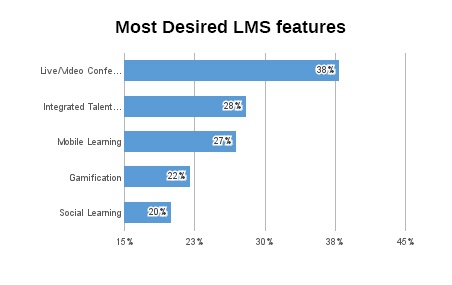
When we began to explore whether technology is making learning better or worse, our first reaction was to think that technology is a tool. Like any tool, it is no more or less productive than the person using it. To a large extent, it proves to be true.
Business leaders are very concerned about a looming skills gap. In Deloitte’s Global Human Capital Trends 2015 survey, learning and development (L&D) is rated as the number 3 most pressing business issue. Of business leaders responding, 74% report learning as “important” but only 46% rate their organizations ready to address the issue.
Growing Demand for Learning
Leaders are asking for more and better learning capabilities. The LMS market is growing at a 25% year over year rate and is showing no signs of slowing down. The most often cited reason for purchase a new system is a dissatisfaction with the capabilities of the current solution.
 Source: LMS Industry User Research Report. Capterra, April 8, 2015.
Source: LMS Industry User Research Report. Capterra, April 8, 2015.
The demand is for e-learning functions, as companies realize the cost savings and benefits of being able to deliver training anytime and anywhere. The most desired function is video conferencing, followed by integrated talent management.
Gamification is becoming more important as content developers learn how to apply the interactions and rewards mechanisms of games technology to motivate learning, and social learning is beginning to prove its value.
According to the Global Human Capital Trends 2015 survey, 87% of companies now rate "retention, engagement, and culture" as an important imperative and 50% rate it "urgent." Leaders are banking on using more engaging and effective learning as the means to improve those measures, and some results are encouraging. The best results come from implementing e-learning as a company-wide cultural and engagement effort.
Conclusion
Our conclusion is that like any tool, how you use your learning technology matters. From our experience, organizations that bank on improvement with technology alone will be disappointed.
Recommendations
Keith Ferrazzi, CEO of Ferrazzi Greenlight, a research and training company, is enthusiastic but cautions that the results of his recent survey and research review indicate executives are struggling with making training and development effective. He gives us several recommendations:
- Ignite managers’ passion to coach their employees. Ferrazzi acknowledges that managers are overburdened, but recommends support and incentives to turn that around. A good thought, but most likely insufficient. As Mark Graban told us in Lean Hospitals: Improving Quality, Patient Safety, and Employee Satisfaction (CRC Press, 2012), “You get what you expect and deserve what you tolerate.” Gently set expectations, and expect the behavior change to take some time.
- Deal with the short-shelf life of learning and development needs. We agree 100%. Skills are becoming obsolete very quickly.
- Teach employees to own their career development. Ferrazzi recommends an individualized approach. In our opinion, it’s the only way that works, and with a robust LMS it is certainly possible.
- Provide flexible learning options. With the many methods available today, a no-brainer. Multiple channels get better results.
- Serve the learning needs of more virtual teams. Social learning is emerging as a learning strategy with big possibilities. If you give them the tools and freedom to do it, your people will create learning communities that multiply the force of learning content.
- Build trust in organizational leadership. Ferrazzi presents this as a kind of will you? Easier said than done, but doable if you go first. Build trust by trusting.
- Match different learning options to different learning styles. This suggestion is about generational differences, but we think new learning styles can apply to all age groups, and they will all appreciate you for it. (Ferrazzi, Keith. “7 Ways to Improve Employee Development Programs.” Harvard Business Review. July 31, 2015.
Phenomecloud is an enthusiastic family of individuals, fervent to make lives simpler through effective use of technology. Our mission is to implement solutions that drives business results. Know more insights from our thoughts and experience.
Contact us today or call 1-855-978-6816 to talk with us about your business needs.





Leave a Comment